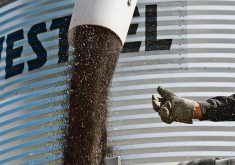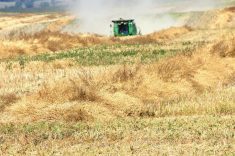LACOMBE, Alta. – This could be a bad year for sclerotinia and blackleg in many canola growing regions, say Agriculture Canada plant disease experts.
However, it’s not a done deal yet.
“The key thing will be what the weather is like during flowering and if the tap shuts off and we start to see temperatures in that 25 to 30 C range, then the risk is going to be quite limited as far as sclerotinia is concerned,” plant pathologist Kelly Turkington of Agriculture Canada’s research centre in Lacombe, Alta., said during a June 30 canola grower tour.
Read Also

Alberta cracks down on trucking industry
Alberta transportation industry receives numerous sanctions and suspensions after crackdown investigation resulting from numerous bridge strikes and concerned calls and letters from concerned citizens
Turkington is studying how to use DNA assessments of canola flowers to more rapidly detect the sclerotinia pathogen.
The process should be ready in two or three years and would help producers decide whether they need to spray fungicide.
“The amount of inoculum that is floating around in July is important,” he said.
“It will be related to the amount of disease that you will see later on in August. Mother Nature will have the trump card as to whether a risk arises or not.”
Blackleg problems at prairie research sites varied from low to high last year, but this summer’s wet conditions could cause an increase.
“This will be our critical year for measurement of blackleg severity,” Turkington said.
Scientists in Western Canada are examining crop rotations, chemical applications and genetic experimentation as they look for ways to beat the troublesome fungus that is more common during prolonged wet conditions.
Randy Kutcher of Agriculture Canada’s research centre in Melfort, Sask., advocates extending canola rotations to once in four years on the same plot of land instead of every three years or less.
“The longer the rotation, the less severity of blackleg and correspondingly, a higher yield,” Kutcher said.
The researchers are also looking at rotating herbicide types and variety mixtures within a single field to add genetic diversity.
“Hopefully by rotating the genes that are in the variety or perhaps by mixing them into the same field, we can add some complexity, which is going to be more difficult for the blackleg pathogen to adapt to,” Turkington said.
Kutcher is studying the genetics and reproduction of the two species of blackleg. Disease resistant genes have been detected but the pathogens can adapt over time and be troublesome again.
Further research may reveal more races of the disease beyond the two strains of Leptosphaeria maculans and Leptosphaeria biglobosa.
China does not have L. maculans and does not want to import it in seeds or dockage because the disease could piggyback on loose stems and pods.
Blackleg appears as small grey lesions with black specks on the leaf surface of canola plants. In some cases, the disease can produce cankers or lesions on the stem, weakening the plant and making it susceptible to lodging or death.















